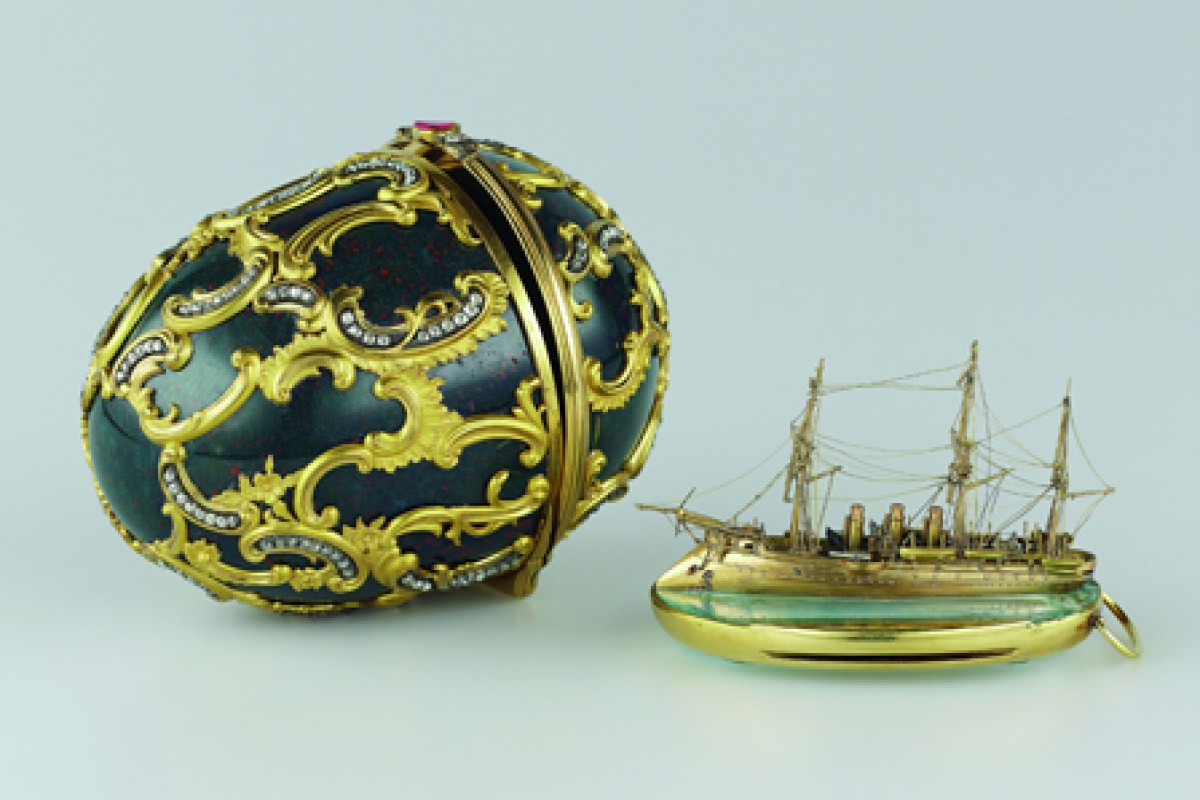 Memory of Azov was a gift from Tsar Alexander III to his wife in 1891 after their Asian trip.
Memory of Azov was a gift from Tsar Alexander III to his wife in 1891 after their Asian trip.The ambitious young man took over the St Petersburg basement shop set up by his father Gustav in 1842, and quickly made his mark on the House of Faberge.
At the height of his career, he became the court jeweller and goldsmith for Tsar Alexander III and Tsar Nicholas II, the last two monarchs of Russia's ill-fated Romanov dynasty.
Today, Hongkongers can marvel at some of his masterpieces at the Hong Kong Heritage Museum's "Faberge: Legacy of Imperial Russia" exhibition, especially the jewelled eggs that made him world-famous.
Between the late 19th and early 20th centuries, Faberge crafted dozens of gemstone-studded, glistening Easter eggs for the Russian emperors.
"The Easter eggs are definitely the highlight [of the exhibit]," notes assistant curator Sunny Tang Hing-hun.
As Russians celebrated the Christian holiday by creating brightly painted boiled eggs, Faberge's artisans honoured the two emperors with 50 bejewelled Easter eggs - and with that, an artistic legacy was born. Their masterpieces serve as a high mark of Russian art from the period.
Sadly, only 11 of the eggs have survived the turmoils of the 20th century.
"The three and a half Easter eggs we have [at the Hong Kong exhibition] are from the Fersman Mineralogical Museum [in Moscow]," Tang says. All the items on show have been borrowed either from there or the Moscow Kremlin Museum.
The small collection of eggs on display include the finished masterpieces Memory of Azoz, The Moscow Kremlin, The Trans-Siberian Train, and the partly finished The Constellation.
Each Easter egg tells its own story. Memory of Azov marked Tsar Alexander III's journey with his family to Asia, during which the royal family also visited Hong Kong.
The Trans-Siberian Train Easter Egg, a gift from Tsar Nicholas II to his wife, celebrated the Trans-Siberian Train railway project, which connected Russia with China, Mongolia and North Korea.
Faberge's craftsmen engraved details patterns such as names and maps onto every piece, which contrast with the protruding, shiny edges created by the finishing touch called chasing, also known as embossing.
All the eggs and jewellery were created using a wide range of refined materials and sophisticated techniques.
Precious metals like gold and platinum were often used, and so were rare gemstones such as rubies and diamonds. Rather than paint their creations, artisans chose gemstones with bright natural colours - such as green emeralds and red rhodonites - to adorn the pieces.
Tang, who organised the exhibition, says the exhibit captures the grandeur of the last Russian dynasty and offers a glimpse of a turbulent chapter of Russian history. "It is very educational especially if you're not familiar with Russian history," Tang says.
As you observe the eggs up close, you may feel like they are small time capsules transporting you into the past. With your interest piqued, you may want to read more about this chapter of history.
Apart from the royal eggs, there is also a collection of everyday handicrafts and religious items on display.
"[It] really reflects how people from all walks of life lived in that period," Tang explains.
But despite its opulent artefacts, the exhibition has been designed not to overload visitors with too much information. Rather, it should be viewed as a droplet in time. "It is about the final days of the Romanov Dynasty," Tang stresses. "That's why it's called a 'legacy'."
"Faberge: Legacy of Imperial Russia" is at the Hong Kong Heritage Museum in Sha Tin and be on display until April 29
